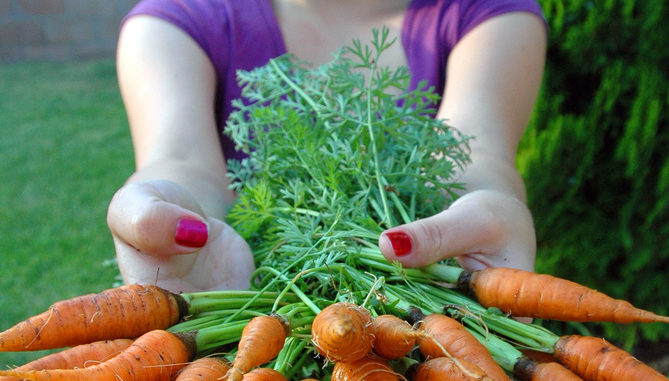
and grow them yourself!
It’s never too late to start growing and eating your own vegetables.
While it might be too late to plant spring vegetables, hot-weather vegetables like okra and peppers will do fine throughout the summer and fall.
During the planning stage, consider where to place the garden and what to plant. Then prepare the soil, fertilize, plant, mulch and finally harvest.
Choosing a place to plant your garden can be critical to its success.
The site should receive a minimum of six hours of direct sunlight. Full or all-day sunlight is preferable, but with so many trees in urban areas, this optimum condition is not always possible. Vegetable plants that do not receive sufficient light will not be as productive.
The site should also be well-drained. Low-lying areas that hold water after a rain are not suitable. Waterlogged soil will prevent roots from obtaining needed oxygen. To improve drainage even more, we typically plant vegetables in raised rows or raised beds.
Next, make a list of what you plan to grow. Plan to grow what you and your family like to eat. On the list, also note how many plants of each you want to plant.
David Pichon, county agent for the LSU AgCenter, said that May and June can be a good time to plant some crops.
Pichon suggested planting peppers, eggplants, okra and hot-weather tomatoes.
“Okra is a heat loving plant,” Pichon said. “We believe the Okra seed was actually carried over by immigrants of slaves in Africa.”
Pichon said that tomatoes have a special hot-weather variety that grows much better in the summer than regular tomatoes.
After choosing, plant only the amount you think you would likely consume fresh and can, pickle, freeze or share. For example, one hot-pepper plant usually yields all the hot peppers a family could want or use. Squash and cucumbers are two other vegetables that often produce more than you may care to eat.
Now the work begins with soil preparation.
Pichon said that anyone who encounters unknown problems or needs advice can call or visit the LSU AgCenter in Luling.
Clear the planting site of all weeds and grass. This can be done by physically removing the unwanted vegetation or by spraying with the herbicide glyphosate. When the weeds have been removed or are dead, turn the soil with a shovel or tiller to a depth of 8 inches.
For best production, the soil should be rich in organic matter. Compost is usually the best choice, but you can use aged manure, partially decayed leaves or peat moss. Spread a 2- to 4-inch layer of organic matter over the tilled area.
Fertilizer can be added on top of the organic matter. Apply a general-purpose fertilizer following package directions for rates. You also may need to add lime, but you will need to get your soil tested through your local LSU AgCenter office to determine if it is needed.
After you apply the fertilizer, mix the organic matter and fertilizer thoroughly with the soil. Turn the soil by digging with a shovel, garden fork or tiller until the added materials are evenly distributed in the soil. A tiller works great for this step.
Next, make raised rows by pulling up the soil with a shovel or hoe to create a raised area. Rows should be about 3 to 4 feet wide from furrow to furrow and as long as you like. Wide rows will result in more planting surface and make more efficient use of your garden area. The bed may be as wide as you like, as long as you are able to comfortably reach the middle without stepping into the bed.
You may decide to build and garden in raised beds.
Raised beds are usually easier to maintain and can be more productive than in-ground beds. They generally are about eight to 12 inches high with sides constructed from materials such as landscape timbers, bricks, cinder blocks or pressure-treated lumber. They should be three to four feet wide and as long as you like. Fill dirt or soil mixes are used to create new raised beds. Your soil provider or nursery can help you decide how much soil you need based on the dimensions of the beds.
By planting in raised rows or raised beds, you improve drainage. This is especially important because of the deluges Louisiana is subject to receive any season of the year.
Mulches are a critical part of vegetable gardening. They suppress weed growth, but they also conserve soil moisture, moderate soil temperatures by keeping it cooler in summer and can prevent some disease problems. Apply one to two inches of organic mulch immediately over a prepared bed until you are ready to plant. Plant transplants directly through the mulch. Pull the mulch aside to plant seeds, and do not replace it over the area until the seedlings are big enough.
Pichon said that guides to growing almost any plant can be found on the AgCenter’s Web site: www.LSUAgCenter.com.
Once you have finished building your garden, you will be able to plant year-long.




Be the first to comment